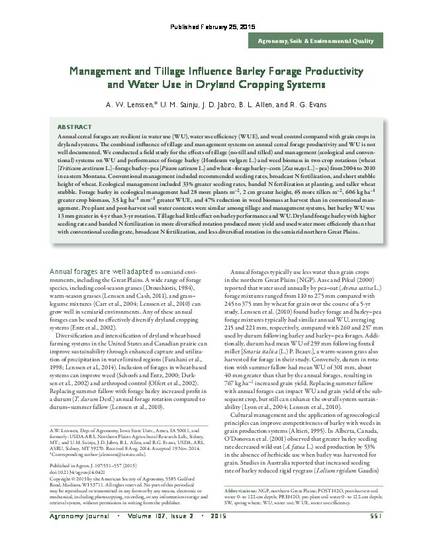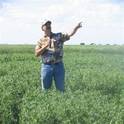
Annual cereal forages are resilient in water use (WU), water use efficiency (WUE), and weed control compared with grain crops in dryland systems. The combined influence of tillage and management systems on annual cereal forage productivity and WU is not well documented. We conducted a field study for the effects of tillage (no-till and tilled) and management (ecological and conventional) systems on WU and performance of forage barley (Hordeum vulgare L.) and weed biomass in two crop rotations (wheat [Triticum aestivum L.]–forage barley–pea [Pisum sativum L.] and wheat–forage barley–corn [Zea mays L.] –pea) from 2004 to 2010 in eastern Montana. Conventional management included recommended seeding rates, broadcast N fertilization, and short stubble height of wheat. Ecological management included 33% greater seeding rates, banded N fertilization at planting, and taller wheat stubble. Forage barley in ecological management had 28 more plants m–2, 2 cm greater height, 65 more tillers m–2, 606 kg ha–1 greater crop biomass, 3.5 kg ha–1 mm–1greater WUE, and 47% reduction in weed biomass at harvest than in conventional management. Pre-plant and post-harvest soil water contents were similar among tillage and management systems, but barley WU was 13 mm greater in 4-yr than 3-yr rotation. Tillage had little effect on barley performance and WU. Dryland forage barley with higher seeding rate and banded N fertilization in more diversified rotation produced more yield and used water more efficiently than that with conventional seeding rate, broadcast N fertilization, and less diversified rotation in the semiarid northern Great Plains.
Available at: http://works.bepress.com/andrew_lenssen/61/

This article is from Agronomy Journal 2015, 107(2); 551-557; doi: 10.2134/agronj14.0421.